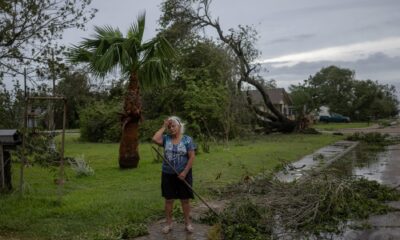Brianna Davies and her family were on a “bucket list” vacation to South Africa during March break in 2020 when it was cut short by the COVID-19 pandemic.
“Trudeau told Canadians to come home and the South African government declared a state of national disaster. There was so much speculation and uncertainty at that time so we packed up and came home,” she told Global News.
It’s been more than a year since then, and Davies says she’s going to adopt a new outlook when things return to some semblance of normal.
“I’m going to say yes more to quality time with my good friends, family, travel and eating out at restaurants,” she said.


Toronto resident Brianna Davies and family on vacation in South Africa in March 2020.
Photo supplied
Davies is like the majority of Canadians who have continued to earn money during the pandemic but have been saving like never before. COVID-19 restrictions have left approximately 40 per cent of workers worse off financially, according to a survey from FP Canada, a national organization of financial planners, published earlier this month. That means the majority of Canadians are in better shape finance-wise. TD Bank estimates collective savings reached a record $200 billion in 2020.


Restrictions on travel and leisure activities leave fewer things to spend money on. Much of that money has instead flowed into the stock market, been used to pay down debt or to renovate or purchase a home. TD Bank Senior Economist Sri Thanabalasingam estimates that “closer to $100 billion” is waiting to be spent. When and if deployed, that would be an enormous boost to the Canadian economy.
Read more:
Here’s where Canadians spent the most money during COVID-19 pandemic
Many economists have surmised that pent-up demand for social interaction, combined with a historic amount of savings, could fuel an economic bump reminiscent of the Roaring 20s. That era of social and financial cutting loose came after the deadly 1918 flu pandemic. The similarities between then and now are striking: the stock market was soaring and people felt the urge to live life to the fullest and spend money.


Female flappers dance while musicians perform in 1926.
Photo by Hulton Archive/Getty Images
In the Conference Board of Canada’s March report “Hope At Last,” the forecast for 2021 includes an economic surge the likes of which we haven’t seen since 2007, during the financial crisis.
Thanabalasingam predicts a big pick-up when restrictions lift across the country, likely starting in the second half of this year and continuing until early next year. That economic rebound could translate to GDP growth of six-to-seven per cent in the last two quarters of this year, he says. But his forecast is dependent on the pace of the vaccine rollout as well as the impact of the more contagious COVID-19 variants.


He says that in late 2020 and early 2021, the easing of restrictions resulted in “very strong” consumer spending, based on debit and credit card data from TD. After weakening in December and January when Ontario and Quebec entered lockdown there was a “solid rebound” in February when restrictions began to lift.
A sudden increase in demand for goods and services after months of low or non-existent demand is bound to create headaches for certain supply chains, as evidenced by what’s already happening in the U.S. Thanabalasingam warns Canadian shoppers to brace for potential shortages. Bike parts and semiconductor chips are already in short supply. A frenzy of shoppers could squeeze other items too.
Read more:
Want to buy a car? The semiconductor chip shortage could affect your selection and price
And after months of tame inflation and a roller-coaster ride for the Canadian economy, which began with an unprecedented plunge a year ago at the onset of the pandemic, there are signs that inflation could flare-up. Historically, as countries emerge from recessions and gross domestic product (GDP) climbs, inflation eventually kicks in although it lags economic gains.
Thanabalasingam says that an initial spurt of inflation could alarm shoppers and make them change their buying habits, thus stoking further inflation.
Read more:
From furniture to toilet paper, Canadians warned of shortages, price hikes amid trade logjams
“If you think that prices are going to be higher tomorrow for a specific product compared to today, you may react by buying that product today,” he says. “If everyone kind of does the same thing, there’s an increase in demand and supply necessarily may not be there. This leads to inflationary pressures.” He describes the phenomenon as a “self-fulfilling prophecy.”
There are a lot of moving parts that could feed into the timing, size and longevity of the recovery, including further aid from the federal government. As well as the ripple effect from the nearly US$2 trillion in stimulus approved south of the Canadian border.


Regardless of when the end of the pandemic — and the green light to resume regular social interactions — arrives, Davies says she’s already planning for it.


Davies on a family trip to Paris in 2019.
Photo supplied
“I really rely on travel as an escape. Not just the actual trip, but planning the trip and looking forward to it gets me through a lot of stressful long days,” Davies says. “I’m super aware of the things I missed during this time and the things that are most important to my family.”
Must See
-




Entertainment
/ 3 weeks agoFaveSzn’s Revelation: Dating Choirmaster at 10 and Sexual Curiosity
Nigerian singer, Chidozie Ugochinyere, popularly known as FaveSzn, has revealed that she once dated...
By Flying Eze -






Europe
/ 3 weeks agoWhy Hungarian Prime Minister Orban visited
Two months later, the leaders of China and Hungary met again. Hungarian Prime Minister...
By Flying Eze -






News
/ 3 weeks agoThree dead and millions without power as Tropical Storm Beryl hits Texas
Man, 53, and woman, 74, killed by fallen trees and third person drowns amid...
By Flying Eze



